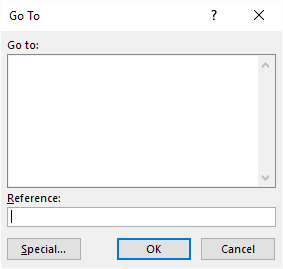Please Note: This article is written for users of the following Microsoft Excel versions: 2007, 2010, 2013, 2016, 2019, 2021, 2024, and Excel in Microsoft 365. If you are using an earlier version (Excel 2003 or earlier), this tip may not work for you. For a version of this tip written specifically for earlier versions of Excel, click here: Displaying a Hidden First Column.
Written by Allen Wyatt (last updated September 27, 2025)
This tip applies to Excel 2007, 2010, 2013, 2016, 2019, 2021, 2024, and Excel in Microsoft 365
Excel makes it easy to hide and unhide columns. What isn't so easy is displaying a hidden column if that column is the left-most column in the worksheet. For instance, if you hide column A, Excel will dutifully follow out your instructions. If you later want to unhide column A, the solution isn't so obvious.
To unhide the left-most columns of a worksheet when they are hidden, follow these steps:

Figure 1. The Go To dialog box.
Another way to display the first column is to click on the header for column B, and then drag the mouse to the left. If you release the mouse button when the pointer is over the gray block that marks the intersection of the row and column headers (the blank gray block just above the row headers), then column B and everything to its left, including the hidden column A, are selected. You can then display the Home tab of the ribbon and click Format | Hide & Unhide | Unhide Columns.
A third method is even niftier, provided you have a good eye and a steady mouse pointer. If you move your mouse pointer into the column header area, and then slowly move it to the left, you notice that it turns into a double-headed arrow with a blank spot in the middle as you position the pointer over the small area immediately to the left of the column B header. This double-headed arrow is a bit difficult to describe; it looks most closely like the double-headed arrow that appears when you position the pointer over the dividing line between column headers. It is different, however, because instead of a black line dividing the double arrows, there are two black lines with a gap between them.
When your mouse pointer changes to this special double-headed arrow, all you have to do is right-click and choose Unhide. Your previously missing column A magically reappears.
ExcelTips is your source for cost-effective Microsoft Excel training. This tip (9012) applies to Microsoft Excel 2007, 2010, 2013, 2016, 2019, 2021, 2024, and Excel in Microsoft 365. You can find a version of this tip for the older menu interface of Excel here: Displaying a Hidden First Column.

Create Custom Apps with VBA! Discover how to extend the capabilities of Office 365 applications with VBA programming. Written in clear terms and understandable language, the book includes systematic tutorials and contains both intermediate and advanced content for experienced VB developers. Designed to be comprehensive, the book addresses not just one Office application, but the entire Office suite. Check out Mastering VBA for Microsoft Office 365 today!
Referring to cells is typically done using a letter and a number, which represent the column and row. That's not the only ...
Discover MoreExcel allows you to freeze rows or columns in your worksheet so that they don't scroll. How you freeze them can be a bit ...
Discover MoreDoes your data require that you perform calculations using circular references? If so, then you'll want to be aware of ...
Discover MoreFREE SERVICE: Get tips like this every week in ExcelTips, a free productivity newsletter. Enter your address and click "Subscribe."
2025-09-27 08:47:25
Alex Blakenburg
I find the quickest way is to use the method 2 selection process ie select Column B using the mouse then drag left but then to just slightly adjust column B's size using the mouse which will make Column A the same size (unhiding it).
For method 1 using Go To, instead of using the Go To function dialogue box simply type A1 into Name Box in the top left corner just above A1 and hit enter. Then follow the instructions for method 1.
Got a version of Excel that uses the ribbon interface (Excel 2007 or later)? This site is for you! If you use an earlier version of Excel, visit our ExcelTips site focusing on the menu interface.
FREE SERVICE: Get tips like this every week in ExcelTips, a free productivity newsletter. Enter your address and click "Subscribe."
Copyright © 2025 Sharon Parq Associates, Inc.
Comments